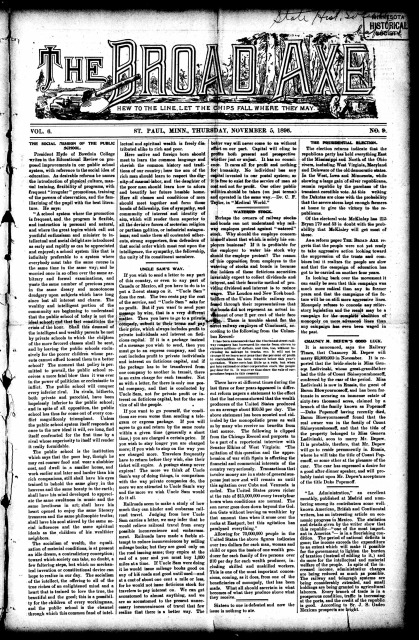The Broad Axe
The broad axe (St. Paul, Minn.) 1891-1903 Browse the title
The Broad Axe was an eight-page, five-column weekly newspaper published in St. Paul from 1891 to 1903 by Albert L. Graves. It served the West Side of St. Paul (at the time, the Sixth Ward) – an area south of downtown St. Paul, but on the west side of the Mississippi River. Predominantly a working-class neighborhood, the West Side of St. Paul during the 1890s and early 1900s was home to several different immigrant groups, including a large number of eastern European and Russian Jews, as well as Germans, Irish, and Scandinavians. Many of these new immigrants came to the area seeking work in the local businesses on the West Side, which included breweries, foundries, quarries, and manufacturing plants.
The Broad Axe was a strongly Democratic paper that took a Populist political stance on the issues of the day, such as supporting the Pullman strikers in 1894. At the time he began the Broad Axe, Albert L. Graves was serving as Assistant Secretary of State for the state of Minnesota, and he began the paper as a means of furthering the Populist agenda that he so strongly supported. The Broad Axe was a staunch supporter of William Jennings Bryan in his presidential campaigns, publishing the full texts of his speeches given at the 1900 Democratic National Convention. By 1902, Graves had retired from the paper, handing the editorial duties to Harley O. Doolittle, who oversaw the paper until it ended publication in 1903.

There is presently some confusion as to whether the Broad Axe, though cataloged as such, should be considered an African American newspaper. There was another newspaper with a similar name, the Broad Ax, published by outspoken African American Julius F. Taylor in Salt Lake City and Chicago around the same time that may have prompted the original cataloging. However, despite sharing a Populist political view and a similar name and motto, “Hew to the line”, the two papers were separate enterprises. Taylor’s Broad Ax is distinctly an African American newspaper, from its declaration of intended audience, to its editorial content and advertising. In contrast, the St. Paul Broad Axe featured very little in the way of African American news coverage or content.